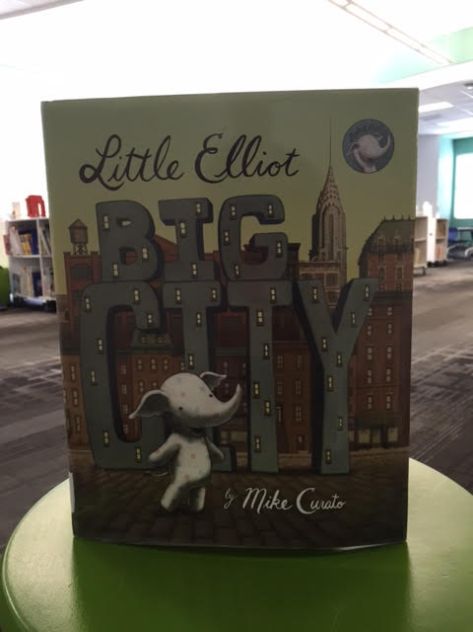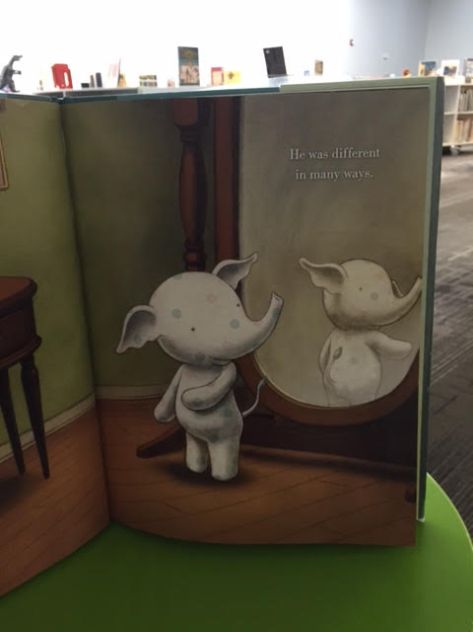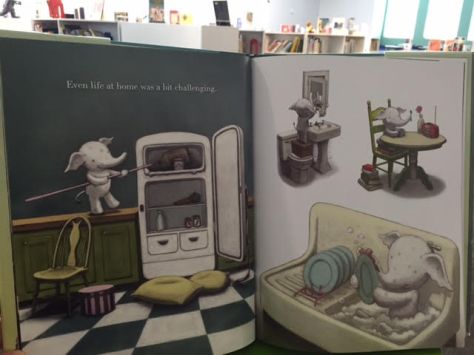Each year I ponder what to do for the first of the year library orientation. Once again, it’s a time where you want to talk about procedures, expectations, etc, but I think more and more about what message I really want students to take away.
This year we are fortunate to have author and illustrator Mike Curato coming to visit our school in October. His book Little Elliot, Big City has so many positive messages for students to start off their year. I decided to use this book as a conversation starter about problem solving, helping one another, being a good friend, and feeling welcome in such a big place.
As students entered the library, I played the book trailer.
Then, we opened with the story. Little Elliot, Big City has very few words on a page, but the discussions that can blossom from those simple words and powerful illustrations are priceless. Over the course of reading the book to students, there were certain pages that started to stand out as the pages I wanted to pause on in order to connect the book with the first visit to the library.
First, we paused here:
Students imagined an elephant in their mind based on what they had seen in a book, movie, or real life. Then, they talked with a partner about all of the differences. We could connect this to all kinds of library ideas such as how different we all are as readers: our interests, our stamina, our favorite authors, and more.
Next, we paused here:
I loved hearing students talk about this page and how Little Elliot was a problem solver. Even though things were challenging, he found ways to persevere. Again, there were so many was to connect to the library and school. We talked about the importance of not giving up, taking a deep breath, trying what seemed impossible, and the more classes I talked to the more ideas surfaced that I hadn’t even thought of.
Probably the most powerful page to talk about was here:
We saw Elliot struggle to be noticed as he went into the city to buy a cupcake. Students came up with all kinds of ways that Elliot could get his cupcake, but then he leaves with nothing. We pondered the question, “Why was Elliot able to be a problem solver at home, but not in the bakery?” Students amazed me with what they said. At home, Elliot was alone and could be brave. In the city, he was shy and scared. Students also talked about how he knew how to use all the tools at his house like his chair, his books, and his broom. However, in the city, he didn’t know how to use things, so he felt helpless. Wow! The conversations just kept coming and each class had a statement that stood out. I wish I had captured the brilliance. It really made me think about all the tools students really need in order to use the library and how that can be a little scary even though I have no intention for it to feel that way. It reminded me of the importance of smiling and patience as students ask over and over how to do things like check out their own books.
Our library really is a massive place, especially for a Kindergarten through second grade student. I don’t want them to ever feel like Elliot did in the cupcake store, so we had some honest conversation about what we could all do to make sure that happened. I was honest with them about how I work alone in the library so there are times that I can’t leave a class to come over and help them. I truly want to, but sometimes it’s just hard for me to do.
Suddenly, those rules and procedures for using a shelf marker had a purpose. I wasn’t just giving students a rule for the library during orientation. I was giving them a tool just like Elliot had his broom. The shelf marker was a strategy for those times that students were unsure. We talked about going to a section of the library and really examining the books on the shelf with a shelf marker rather than searching on the computer.
We also talked about how Elliot was a helper to mouse in the story and that we really all have to be like Elliot at some point. We have to help one another. We can’t wait on one person to be the person to help us. Whether it’s another adult roaming the library, a student from another class, or a volunteer, we can ask anyone in the library to help us access what we want.
I really didn’t plan for Elliot to have so many connections to library orientation, but he did. It just evolved. Students left with a positive story, a strategy for finding books, and I hope a sense that the library is a welcoming place where we all take responsibility to help one another.















